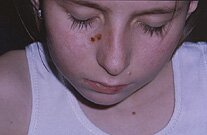| |
June 2000
Case of the Month: A nine year-old HIV-infected girl presents with a lesion on her face.
Answer: Cutaneous Cryptococcus neoformans infection

Discussion: Cryptococcal infection in individuals with AIDS can manifest with meningoencephalitis, pneumonia, or disseminated disease, which sometimes includes skin lesions. Cutaneous cryptococcosis is included in the differential diagnosis of a variety of skin lesions in individuals with HIV, and must be promptly recognized and treated. Skin lesions can be single or multiple, and may appear as small papules, pustules, nodules, or ulcers with a base of granulation tissue. Umbilicated papules in individuals with HIV can resemble molluscum contagiosum. Diagnosis can be made by periodic acid-Schiff (PAS) staining of biopsy specimens, which may reveal encapsulated budding yeast. Cultures of tissue or blood, and determination of cryptococcal antigen titers by latex agglutination, can be helpful. Treatment of cutaneous cryptococcosis is not well established. Cases of disseminated disease require systemic induction therapy, usually with amphotericin B or fluconazole, followed by life-long suppressive therapy with fluconazole.
|